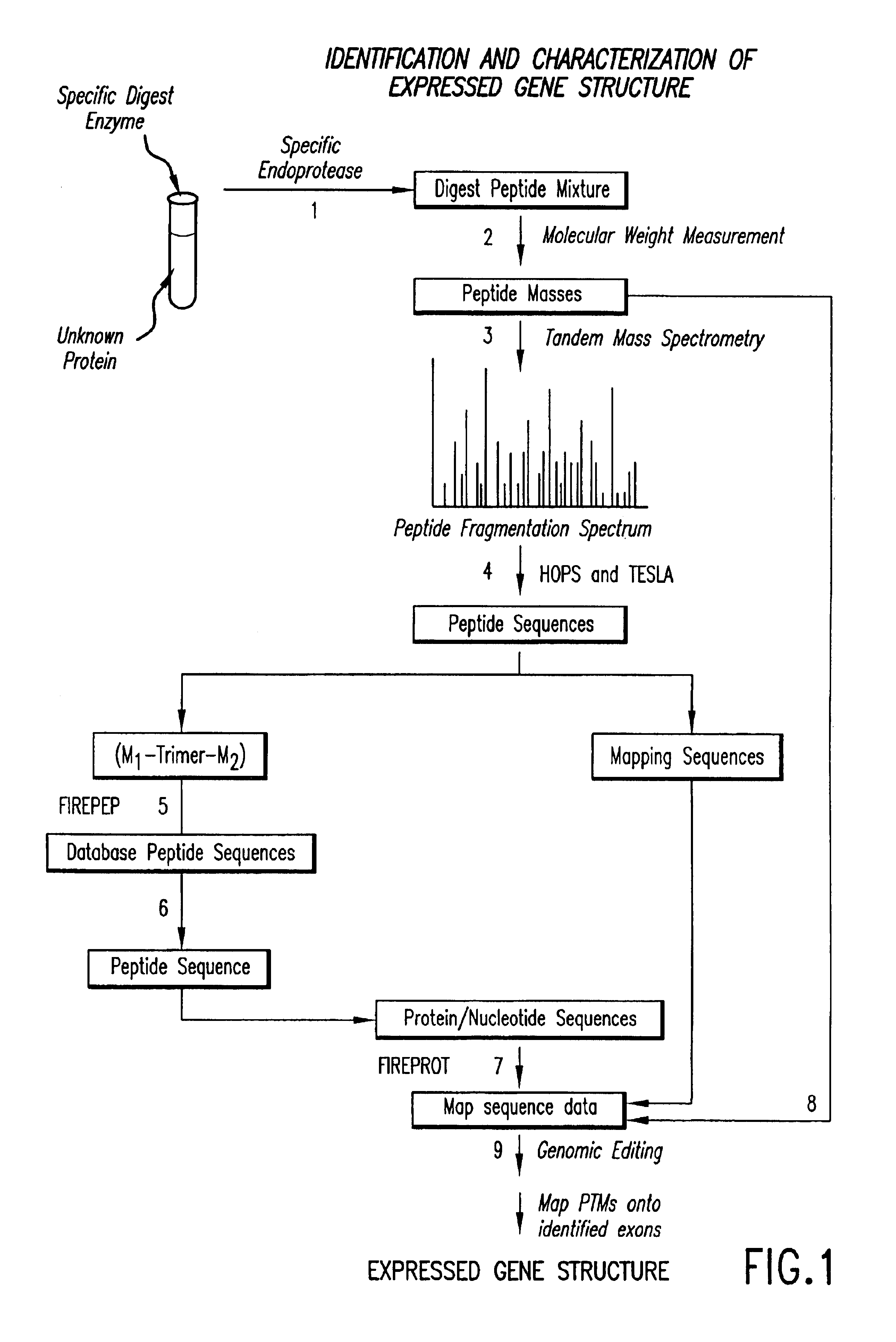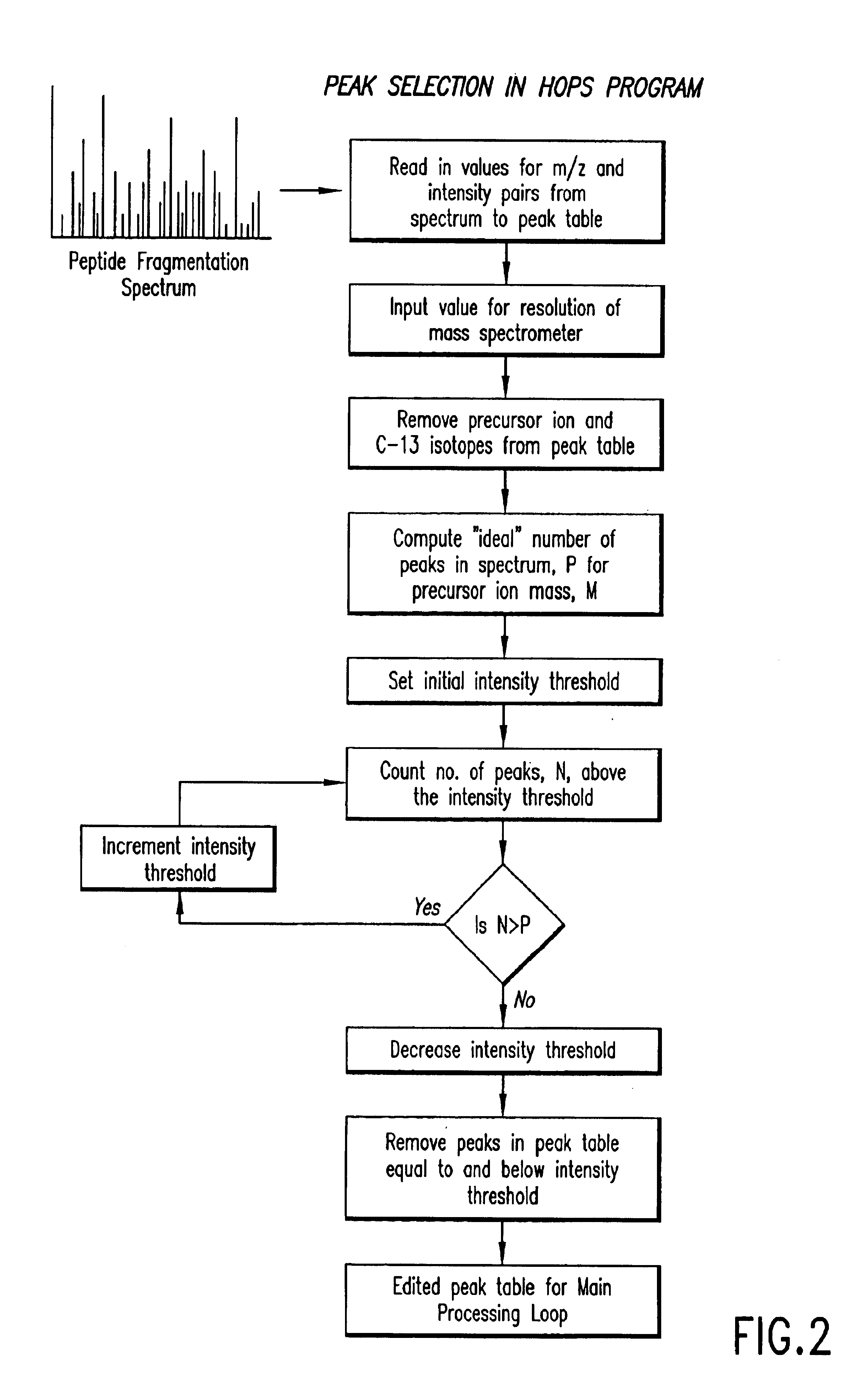Automated identification of peptides
a technology of automatic identification and peptides, applied in the field of automatic identification of peptides, can solve the problems of inaccurate sequence determination and manual spectral interpretation of art algorithms, and achieve the effect of rapid identification of nucleotides
- Summary
- Abstract
- Description
- Claims
- Application Information
AI Technical Summary
Benefits of technology
Problems solved by technology
Method used
Image
Examples
example 1
5.10 EXAMPLE 1
[0181]In one example of the present invention, a database is constructed from a combination of human genomic sequence entries in the database held at the European Molecular Biology Laboratory (EMBL), peptide entries in the non-redundant database held by the National Centre for Biotechnology Information (NCBI) which is accessible at hffp: / / www.ncbi.nlm.nih.gov / and peptide sequence entries held at the SWISSPROT database held at the Swiss Institute of Bioinformatics (SIB). The genomic sequences (including edited as well as unassembled, unordered segments of the genome) are translated, in all three reading frames and in both directions, into a computer listing of predicted amino acid sequences by applying the rules of the genetic code to form conceptually translated peptide sequences. The theoretical peptide sequences are conceptually cleaved at the residues predicted by the specificity of trypsin to generate a list of predicted tryptic fragments. Peptides containing stop...
example 2
5.11 EXAMPLE 2
[0183]Peptide sequences are derived by conceptual translation of genome sequences and subjected to in silico trypsinolysis. Fragmentation mass spectra are interpreted by HOPS and the conceptually translated database is searched with FIREPEP to identify matching peptide sequences. Where a peptide sequence is identified that matches the search string, a cross-referencing algorithm identifies the contig in the genomic database from which the matching peptide has been translated. A set is then formed from all in silico digested sequences encoded by that contig. A mass matching algorithm is used to assign recorded masses to sequences within the set of translated peptide sequences. Sequences deduced from spectral read of tandem spectra are mapped onto the set of translated sequences. In addition, observed masses are attributed to molecular weight increments and decrements to account for post-translational modifications of interest. As shown in FIG. 13, the output of database...
example 3
5.12 EXAMPLE 3
[0184]It is well recognised that changes in single nucleotides occur with high frequency among the genomes of individuals. The biological consequences of single nucleotide polymorphisms (SNPs) can be profound. The propensity to develop a form of Alzheimer's disease is associated with a single base pair change in apolipoprotein E (Apo E) which converts the Cys residues at position 130 (the ε3 isoform) to Arg (ε4 isoform). The tryptic peptides containing the amino acid change from the SNP are (R)LGADMEDVCGR (SEQ ID NO.: 21) and (R)LGADMEDVR (SEQ ID NO.: 22) for isoforms ε3 and ε4, respectively. Apolipoprotein E peptides from individuals with the ε3 and ε4 polymorphism were analysed according to the present invention. Two SNP specific tryptic peptides were produced which yielded the following M1-trimer-M2 sequences: M1=241 (DME) M2=573 (ε3), and M1=241 (DME) M2=476 (ε4). The SNP search sequences were used to search the human genome peptide database with the FIREPEP module...
PUM
| Property | Measurement | Unit |
|---|---|---|
| temperature | aaaaa | aaaaa |
| intensity threshold | aaaaa | aaaaa |
| atomic mass | aaaaa | aaaaa |
Abstract
Description
Claims
Application Information
 Login to View More
Login to View More - R&D
- Intellectual Property
- Life Sciences
- Materials
- Tech Scout
- Unparalleled Data Quality
- Higher Quality Content
- 60% Fewer Hallucinations
Browse by: Latest US Patents, China's latest patents, Technical Efficacy Thesaurus, Application Domain, Technology Topic, Popular Technical Reports.
© 2025 PatSnap. All rights reserved.Legal|Privacy policy|Modern Slavery Act Transparency Statement|Sitemap|About US| Contact US: help@patsnap.com



